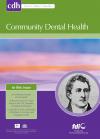Community Dental Health

- Cover Date:
- March 2006
- Print ISSN:
- 0265 539X
- Vol:
- 23
- Issue:
- 1
Dental caries and enamel fluorosis among the fluoridated population in the Republic of Ireland and non fluoridated population in Northern Ireland in 2002
Background An all Ireland/North South survey of Oral Health was carried out in 2001/2002. Aims: To compare levels of dental caries and enamel fluorosis among children and adolescents in the fluoridated Republic of Ireland (RoI) with those in the non fluoridated North of Ireland (NI). Methodology: Cross sectional oral health survey of a representative, random, stratiï¬ed sample of 5-, 8-, 12- and 15-year-olds in RoI and in NI (N=19,950). WHO examination criteria with the addition of visible, non cavitated dentine caries were used for recording caries. Fluorosis was measured using Dean’s Index. Results: In the RoI, the mean d3cmft / D3cMFT for 5-, 8-, 12-, and 15-year-olds with full domestic water fluoridation (n=9,975), was 1.0, 0.3, 1.1 and 2.1 respectively. The corresponding means in non fluoridated NI (n=1,475) were 1.8, 0.3, 1.5 and 3.6 respectively. (p<0.0001, NS, p<0.0005 and p<0.0001 ). The prevalence of enamel fluorosis has increased in RoI since 1984, 23% and 36% of 8- and 15-year olds respectively in fluoridated areas had Dean’s Index scores at the questionable or greater level in 2002 compared with 6% and 5% respectively in 1984. Conclusions: In 2002 apart from 8-year-olds, caries levels were lower amongst children resident in fluoridated communities in RoI than amongst corresponding age groups in non-fluoridated NI. Caries has declined in fluoridated and non fluoridated groups in both jurisdictions since the early 1960s. In RoI fluorosis levels were higher amongst lifetime residents of fluoridated communities and have increased since 1984. Key Words: Caries, epidemiology, fluoridation, fluorosis, national survey
Introduction
The island of Ireland is governed under two jurisdictions, the Irish (Republic of Ireland) and British (Northern Ireland) governments. Thus oral health care services are delivered within two different health care delivery systems. One of the major differences likely to impact on oral health is the level of fluoride in domestic water supplies. Since the implementation of the Health (Fluoridation of Water Supplies) Act (1960), in 1964, domestic water supplies in the Republic of Ireland (RoI) have been adjusted to 0.8 to 1.0 parts per million (ppm) fluoride. Currently 71% of the population of the RoI receive fluoridated domestic water supplies. There are no water fluoridation programmes in Northern Ireland (NI). Epidemiological studies conducted in the early 1960s indicated that dental caries levels in Dublin (RoI) (Minister for Health, 1961-1965) and Belfast (NI) (Sheane 1963) were similar prior to water fluoridation. More recent reports indicate that caries levels in NI were higher than in fluoridated areas of the RoI (Forum on Water Fluoridation, 2002) However none of the studies reported were contemporaneous and different caries diagnostic criteria were used. This study is the ï¬rst contemporaneous North/ South study of the oral health of children and adolescents in both jurisdictions. A criticism of past studies of the effectiveness of water fluoridation was their failure to control for confounding factors (McDonagh et al., 2000). Socio economic factors are important variables to take into account when
comparing caries levels amongst different communities. Since the ‘Black Report’ on inequalities in health was published in the UK (Townsend and Davidson, 1980), the association between disadvantage and ill health has been widely acknowledged. As with general health, there are many reports of poorer oral health among the less well off. It has been reported that water fluoridation reduces this inequality (Jones and Worthington, 2000) It is well established that persons residing in fluoridated communities have higher levels of questionable and very mild fluorosis (Dean et al, 1954). A national survey conducted in RoI in 1984 and local studies conducted since then have indicated that there is a slight increase in these levels of fluorosis amongst Irish children and adolescents (O’Mullane et al 1986, Whelton et al 2001). The study reported in this paper had three main aims. Firstly, to compare the prevalence of caries among child and adolescent residents in fluoridated communities in RoI with residents of non-fluoridated communities of NI whilst controlling for disadvantage. Secondly, to compare the levels of dental fluorosis in fluoridated (RoI) and non-fluoridated (NI) communities. Finally, to compare changes in caries levels over time in RoI and NI. A comparison of caries and fluorosis between children and adolescents with fluoridated and non fluoridated water supplies in RoI has been reported previously (Whelton et al 2004). This paper focused on comparing caries and fluorosis levels in the fluoridated samples in RoI and the non fluoridated sample in RoI. The halo effect of water fluoridation must be considered when comparing caries
Correspondence to: Dr Helen Whelton, Oral Health Services Research Centre, University Dental School and Hospital , Wilton, Cork, Ireland. Email: H.Whelton@ucc.ie
CDH 2175-Whelton.indd 37
21/02/2006 12:31:36
- Article Price
- £15.00
- Institution Article Price
- £
- Page Start
- 37
- Page End
- 43
- Authors
- H.Whelton, E. Crowley, D. O’Mullane, M. Donaldson, M. Cronin, V. Kelleher
Articles from this issue
- Title
- Pg. Start
- Pg. End
- Satisfaction with the oral health services. A qualitative study among Non-Commissioned Ofï¬cers in the Malaysian Armed Forces
- 15
- 20
- Root canal treatment in a population-based adult sample: differences in patient factors and types of teeth treated between endodontists and general dentists
- 21
- 25
- Oral Health in 8-9 year-old children in Saxony-Anhalt (Germany) and in two Hungarian cities (Budapest and Debrecen)
- 26
- 30
- Dental caries and enamel fluorosis among the fluoridated population in the Republic of Ireland and non fluoridated population in Northern Ireland in 2002
- 37
- 43
- Short communication - Areca nut use amongst South Asian schoolchildren in Tower Hamlets, London: The extent to which the habit is engaged in within the family and used to suppress hunger
- 58
- 60
